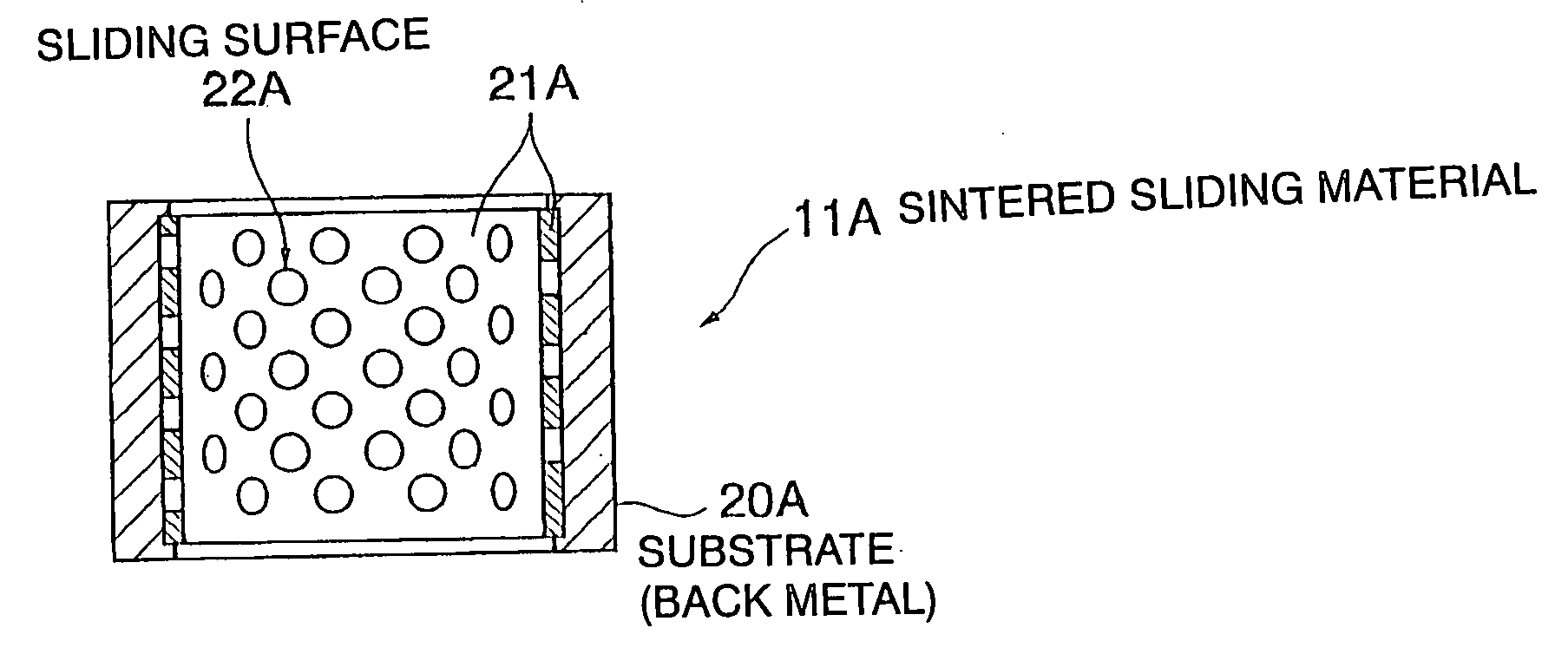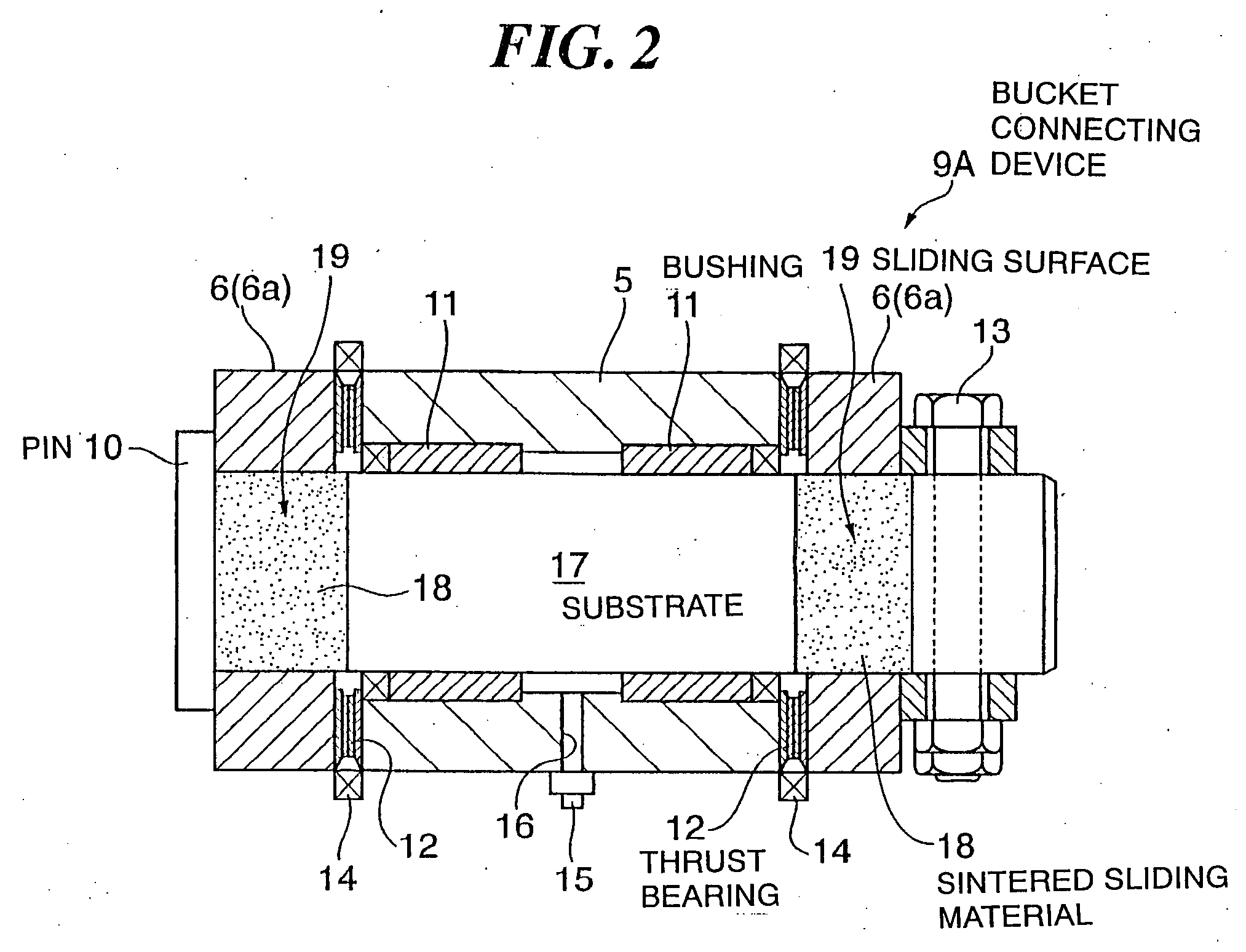Sintered sliding material, sliding member, connection device and device provided with sliding member
- Summary
- Abstract
- Description
- Claims
- Application Information
AI Technical Summary
Benefits of technology
Problems solved by technology
Method used
Image
Examples
embodiment 1
[0085]FIG. 1A is a perspective view showing a hydraulic shovel according to the first embodiment of the present invention and FIG. 1B is an exploded perspective view showing a bucket connecting device of the hydraulic shovel. FIG. 2 is a cross sectional view schematically showing a structure of the bucket connecting device according to the first embodiment of the present invention. FIG. 3A is a cross sectional view showing a structure of a bushing and FIG. 3B is a cross sectional view showing a structure of a thrust bearing.
[0086] As shown in FIG. 1A, an operating portion 2 of a hydraulic shovel 1, according to this embodiment, is provided with an upper turning body 3 to which a boom 4 is connected by a boom connecting device 7. The boom 4 is connected to an arm 5 by an arm connecting device 8, and the arm 5 is connected to a bucket 6 by a bucket connecting device 9. These connecting devices 7, 8 and 9 have the same fundamental structure. For example, the bucket connecting device 9...
embodiment 2
[0106]FIG. 4 is a cross sectional view schematically showing a structure of a bucket connecting device according to the second embodiment of the present invention. The bucket connecting device 9B has the same basic structure as that of the first embodiment except for structures of a connecting pin and a bushing. Hereinafter, only the specific structures in this embodiment will be explained, and the parts common to the first embodiment are represented with the same number as the first embodiment and description thereof is omitted.
[0107] A connecting pin 26, in this embodiment, is provided with a steel substrate (a back metal) 27 functioning as an axis and sliding surfaces 29 which is made of a sintered sliding material 28, according to the present invention, combined with the substrate 27. In the connecting pin 26, the sliding surfaces 29 are formed at portions where the connecting pin 26 is sliding-contacted with the brackets 6a and the bushings 30.
[0108] The bushing 30 is compose...
example 1
[0194] Next, the preferred examples of the present invention will be described in detail with reference to accompanying drawings.
(Producing Method of Sintered Sliding Material)
[0195] In this example, using Mo(1) powder (an average grain size of 0.8 μm), Mo(2) powder (an average grain size of 4.2 μm), NiO (an average grain size of 0.7 μm), atomized Cu powder (manufactured by Nippon Atomized Metal Powder Corporation, SFR—Cu, an average grain size of 0.8 μm), Ni powder (an average grain size of 0.8 μm), TiH powder under #350 mesh and Sn powder under #350 mesh, various types mixed powder shown in table 1 were prepared. And, each mixed powder was blended with paraffin wax of 3 wt % with respect to the mixed powder and then formed with a pressure of 2 ton / cm2 into a cylindrical-shaped compact with an inner diameter of 46 mm and a height of 50 mm. Then, each compact thus obtained was sintered at 950 to 1250° C. for 1 hour and then cooled with N2 gas.
TABLE 1CONPOSITIONS(wt %)0.8μm4.7 μ...
PUM
| Property | Measurement | Unit |
|---|---|---|
| Grain size | aaaaa | aaaaa |
| Grain size | aaaaa | aaaaa |
| Grain size | aaaaa | aaaaa |
Abstract
Description
Claims
Application Information
 Login to View More
Login to View More - R&D
- Intellectual Property
- Life Sciences
- Materials
- Tech Scout
- Unparalleled Data Quality
- Higher Quality Content
- 60% Fewer Hallucinations
Browse by: Latest US Patents, China's latest patents, Technical Efficacy Thesaurus, Application Domain, Technology Topic, Popular Technical Reports.
© 2025 PatSnap. All rights reserved.Legal|Privacy policy|Modern Slavery Act Transparency Statement|Sitemap|About US| Contact US: help@patsnap.com



